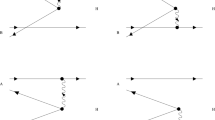Summary
This paper concerns the models for meson production which make use of an intermediary excited nucleon X having a short lifetime, Ex. π+N → π+X → π+π+N. The legitimacy of drawing from such a hypothesis, together with charge independence, simple clear cut conclusions as to the relative numbers of mesons created with various charges is discussed. It is shown that, contrary to what might be expected at first sight, these ratios depend, in a complicated way, on the line width (lifetime) of the excited state. Only in the case of a line width small compared to excitation energy do they reach the values given by the more customary and elementary approach. Isotopic spin conservation is assumed. For simplicity calculations have been made using scalar meson theory without recoil; reactions (1) and (2) are treated as an example. The method consists in calculating the matrix elements of theT matrix for the whole process, i.e. without supposing implicitly that X be real. The intermediary state hypothesis is introduced by keeping only the graphs of Fig. 3. The important contributions of damping, given by the graphs of Fig. 2, are taken into account by solving the appropriate Heitler equations. The general result for our example is given by (22). A discussion of this formula shows that the limiting value of σ0+/σ++ can hardly be a good approximation unless the line widthΓ of the excited state is less than about a tenth of its excitation energyΔ. We conclude that whenX is identified with theI=J=3/2;Δ=150 MeV,Γ ≈ 80 MeV excited state of the nucleon, the elementary approach for the calculation of such ratios should not be considered as reliable.
Riassunto
Il lavoro si occupa dei modelli per la produzione di mesoni che fanno ricorso all’ipotesi di un nucleone intermedio eccitato X di vita breve,Es. π+N → π+X → π+π+N. Si discute la legittimità di trarre da tale ipotesi in unione all’indipendenza della carica conclusioni semplici e ben definite riguardanti i numeri dei mesoni creati rispettivamente con varie cariche. Si dimostra che, contrariamente a quanto si potrebbe ritenere a prima vista, questi rapporti dipendono, in modo complesso, dall’ampiezza della riga (vita media) dello stato eccitato. Solo nel caso di un’ampiezza di riga piccola in confronto dell’energia di eccitazione detti rapporti raggiungono i valori dati dai metodi più usuali ed elementari. Si ammette la conservazione dello spin isotopico. Per semplicità i calcoli sono stati eseguiti servendosi della teoria mesonica scalare senza rinculo; le reazioni (1) e (2) si trattano a titolo di esempio. Il metodo consiste nel calcolare gli elementi della matriceT per l’intero processo, cioè senza supporre implicitamente che X sia reale. L’ipotesi di uno stato intermedio si introduce conservando solo i grafici di fig. 3. Nella soluzione delle opportune equazioni di Heitler si tiene conto degli importanti contributi di smorzamento dati dai grafici di fig. 2. Il risultato generale è dato per il nostro esempio dalla (22). La discussione di questa formula mostra che il valore limite di σσ0+/σ++ può difficilmente essere una buona approssimazione a meno che la larghezza di rigaΓ dello stato eccitato sia inferiore a circa 1/10 della sua energia di eccitazioneΔ. Si conclude che, seX si identifica con lo stato eccitato del nucleoneI=U=3/2,Δ=150 MeV,Γ=80 MeV, il metodo elementare per il calcolo di tali rapporti non si può considerare attendibile.
Similar content being viewed by others
References
W. B. Fowler, R. P. Shutt, A. M. Thorndike etW. L. Whittemore:Phys. Rev.,95, 1026 (1954).
L. C. L. Yuan etS. J. Lindenbaum:Phys. Rev.,93, 1431 (1954);S. J. Lindenbaum etL. C. L. Yuan:Phys. Rev.,95, 638 (1954).
W. D. Walker, J. Crussard etM. Koshiba:Phys. Rev.,95, 852 (1954).
L. M. Eisberg, W. B. Fowler, R. M. Lea, W. D. Shephard, K. P. Shutt, A. M. Thorndike etW. L. Whittemore:Phys. Rev.,97, 797 (1955).
D. C. Peaslee:Phys. Rev.,94, 1085 (1954) et95, 1580 (1954).
B. d’Espagnat:Compt. Rend.,240, 164 (1955).
B. d’Espagnat etJ. Prentki:Compt. Rend.,240, 1514 (1955).
B. A. Lippmann etJ. Schwinger:Phys. Rev.,79, 469 (1950).
Une autre possibilité de décomposition serait de grouper un des mésons finaux avec le nucléon ce qui pourrait même sembler plus conforme à la nature du présent problème. La méthode que nous avons choisie s’avère cependant plus maniable. Je profite de cette note pour signaler que le raisonnement fait en (6) est trop sommaire à cet égard (B.E.).
Author information
Authors and Affiliations
Rights and permissions
About this article
Cite this article
d’Espagnat, B., Prentki, J. La production des mésons et les états excités à vie moyenne brève. Nuovo Cim 1, 1223–1237 (1955). https://doi.org/10.1007/BF02731425
Received:
Published:
Issue Date:
DOI: https://doi.org/10.1007/BF02731425



